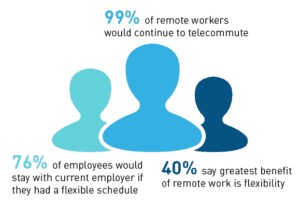In 2019 remote workers made up only 2.9% of the American workforce. By mid-2020, that number had skyrocketed to over 33% and has shown no signs of slowing down.
Remote work offers several benefits for both employers and their employees. 40% of remote workers feel the greatest benefit to telecommunication is schedule flexibility. In fact, 76% of workers say they would be willing to stay with their current company if they could have a flexible work schedule and 99% of remote employees say they want to continue telecommuting in the future, according to a survey conducted by Buffer.
That is not all; for employers, remote work could prove even more beneficial. On average, each employee working remotely will save a company $11,000 in utilities, janitorial, rent, and other office related costs, according to data from Global Workplace Analytics. Owl Labs reports that organizations allowing remote work are showing a 25% less turnover rate and have the added benefit of a widened talent pool that is not limited by a business’ office location.
While there are benefits to working remotely, there is also a stumbling block that today’s telecommuter and their employers are facing: disengagement. When employees are not engaged, your company could incur significant losses. Gallup estimates that employee disengagement costs the US economy as much as $350 billion every year. Broken down further, that represents at least $2,246 per disengaged employee per year!
So how can a modern business and its employees symbiotically take advantage of all that telecommuting has to offer, while at the same time, keeping engagement a top priority? Here are 5 strategies that have worked across many organizations and industries.
1. Make checking in and staying connected a priority.
Regularly scheduled group and one-on-one meetings are key to good communication, but when not executed well, can cause disengagement. Meetings should be informative, have clear purpose and direction, and when possible, be on video. When in doubt, less is more; keep it short and concise.
One-on-one time should be used to build a relationship with each employee and give them a chance to report on their individual progress. This is also
a good time to ask your employee what they need support in and how you can help them stay on track. In a group setting, incorporate activities with high participation aspects. Ask for progress reports, take time to learn something together, have an open Q&A, or bring a problem to the table that your team can solve together. This will build camaraderie and a sense of purpose for your team.
To wrap up your group meetings, build in some time for “water cooler” chat. Casual conversations happen less frequently when working remotely, but these opportunities help build rapport with coworkers and are an important component to creating a friendly and inviting workplace.
2. Create and follow a standard dress code.
Consistent virtual meetings and the expectation of being on camera has another benefit; employees will feel more inclined to “get dressed” for work. Self-presentation helps put people in a work mindset, and the expectation that they will be seen on camera sets the bar for a more professional appearance. According to a recent survey of 1,000 remote workers: approximately 80% of formal dressers said they felt productive throughout the day vs. the 50% of those who dress in pajamas.
3. Recognize accomplishments and celebrate.
According to information collected by Gallup, only a third of workers in the U.S. strongly agree that they receive recognition or praise for doing good work. In a remote environment, managers should pay particular attention to identifying their teams’ successes and recognizing them in a timely manner.
Social and collaborative internal platforms, like Microsoft Teams, will help you acknowledge hard work and success for all to see. This will also encourage other employees to participate in the kudos and celebrations, creating an amplified effect on your efforts and snowballing positive engagement. Moreover, by recognizing and publicly celebrating the success of your team, you will encourage repetition and imitation of those same behaviors.
4. Agree upon set expectations.
Having a set of guidelines for working remotely is critical to eliminating surprises and poor use of time. With the input of your team, come to an agreement on activities such as taking breaks and preferred methods of communication. In addition, these expectations for daily duties should be specific and well-communicated to help elimination differences in interpretation. For example:
“Phone calls must be returned in a timely manner.”
vs.
“All customer inquiries are expected to be addressed, at minimum, within 1 business day.”
5. Make room for fun!
A 2015 study found that happier employees are more productive by an average of 12%. This difference is significant, given that productivity rises of more than 3% are considered very large. Having fun at work has also been proven to improve teamwork, build trusting relationships, and increase employee retention. Some studies have even shown that encouraging casual creativity helps your staff develop problem solving skills for use in business problems. Encourage your staff to come up with ideas and get their input on what they would like to do.
Creative ideas to help you get started are:
- Stream a movie or TV show
- Have an in-home scavenger
- Extend lunch breaks with a crafting
- Hold a team happy hour, if that fits your company’s culture!
The Takeaway
It is worth noting that all these tactics can be applied to an in-person workplace setting just as easily as they can be used remotely. In an ever-changing workplace landscape, your most important asset is the people you employ. Keeping your team engaged will result in increased performance, enhanced workplace culture, and significant cost savings to your bottom line.




